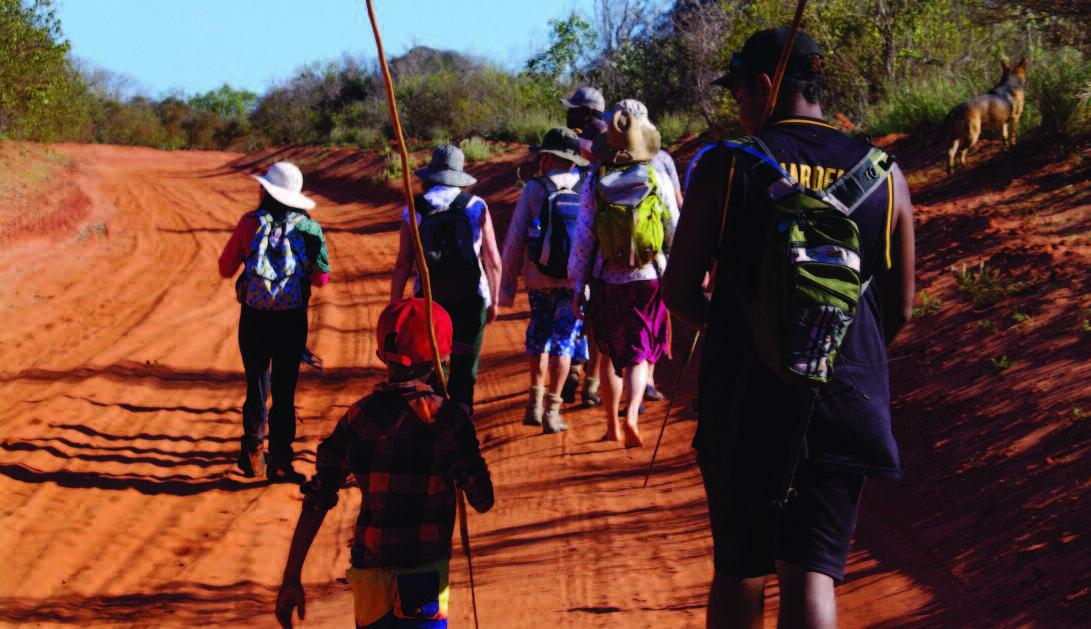
2017 - LURUJARRI TRAIL
I talked to Jen Hall who, with her sister Kath walked the Lurujarri Trail in October 2016 with the Goolaraboo mob.
Jen was particularly interested to learn more about the Aboriginal culture as she lives in Broome and works with indigenous youth. I asked her if this experience delivered everything she wanted. Her answer was no…. but it gave her something else.
This is the story of their 9-day walk along the coast of Broome. A coastal strip of sand dune, paperbark scrub, high tide estuaries and creeks. The walk takes you on a journey to see this country, but it also takes you to find a new pace and a way of seeing.
‘We were in a group of 15 people and a handful of local guides and looking forward to the walk to learn about country and aboriginal culture. It was on my bucket list, and I wanted to see a bit of Kimberley culture, Broome culture, and to walk with local people. Because it was along the coast a beautiful beach made it perfect. We wanted to hear stories of the song lines and of culture and about the area we were walking.
It was a unique 9 days. Not what we expected but not arduous or harsh. It was well organised which meant we could walk stress free. If we tired, they would find a big tree or rock overhang and we would have a snooze or sit and yarn. We slowed down, walking at the pace of the country, we found a different way of relating to people and a different way of relating to the land and the sea.
For the first 3 days we received very little input from the local guides. I think that was a good thing, as it gave us a chance to drop our city and western outlook. Everyone had come out of working lives and were eager for a new experience. We slowed down, learnt to see things differently and to drop our expectations, high needs and demands.
We walked sometimes on the beach, sometimes in the dunes and also along tracks. During the day we would stop in a shady area and eat the fresh fruit stashed in our pockets, enjoying the quiet and the difference.
We rose predawn to incredible coloured sunrises with the opportunity to roam alone along deserted beaches. Most times we walked barefoot in our bathers, swimming when we got hot at incredible isolated beaches feeling privileged to be in the unique setting virtually alone. Incredible bonds were created between the visiting walkers, learning each other’s stories and about each other’s lives while walking and yarning beside someone different each day.
Some days were long early walks timed to cross creeks at low tide and to avoid the midday sun. Most days we walked less than 10 kms, easy, flat walking at a gentle pace with lots of stops and the chance to swim and chat along the way.
We crossed pebbly sand dunes littered with artefacts, saw an ancestor’s grave and were shown grinding stones used near middens of shell. We learnt how to recognize water indicating paperbarks and pandanus palms and where good places to camp were.
We moved between bush blocks owned by family where night camps were set up with drop toilets behind screens, flat places to lie our swags and open places for the communal kitchen. At each camp we were welcomed by a continuous billy of hot tea over a fire and the sounds of camp being set up. After setting up our own swags or tents we enjoyed some time alone sometimes washing our clothes, snoozing on the beach, strumming a guitar or watching the amazing colours of the Kimberly sunset.
The food was plentiful, local Broome style family curries and big pots of stew or fried rice and over dinner more conversation with fellow walkers. We observed the moon grow larger each day from a tiny crescent resting on the horizon and every night settled into our various camp beds tired, a little sun burnt, and sand fly bitten but calmer, stressed less and at peace.
Each day the group drew closer together. Slowing and relaxing into the country. We met under wide branched trees to yarn at lunch and share stories till the sun dropped lower and the day cooled enough to walk on. We got to know how a modern Aboriginal family spends their time with family. Sharing fishing, crabbing and hunting. Unfortunately, 2016 was a very dry season so we saw little of the local bush foods as there was limited fruit but we did get to recognise and taste the nectar of the red Jigal flowers. Some of us were shown how to catch mud crab at low tide and how to fish and knock oysters off the rocks to slurp them juicily into our open mouths.
We walked across Barred Creek at low tide to one overnight camp and returned later in the day to fish on the high tide amazed that there were no crocodiles and that the creek we walked had become too deep and wide to even swim across. Everyone came away saying that they felt more connected to the country, that they understood a slower pace and more about other ways to communicate and other ways to learn. We were able to observe a modern Aboriginal Broome family. How they spent weekends on their block, taking the grandparents and relatives and a mob of kids out on the rocks, fishing, netting and exploring the rock pools and beaches. They know the tides, they catch turtle and crabs and then head back to Broome relaxed, well fed and rejuvenated.
We were expecting more though, especially as I already lived in Broome and worked with Aboriginal people. I wanted a deeper understanding of the history and stories of the coast we walked through. The family didn’t share the evening yarns around the fire and there were no stories of their song lines. A staged dance on the last night lacked authenticity and depth. We did, however get the story of the last 35 years of the Roe family in the area, and their fight to save James Price Point from gas development. And we certainly got a close and personal insight to a modern aboriginal family and how they function in today’s world.
The Lurujarri Trail took us on a journey we did not expect, it taught us to look at life in a different way and to slow to a different pace. It has taken a while to get used to being back in the 21st century and to the mad pace of work and life! What each walker learnt was different and our experience of the walk varied but overall, the Kimberley coast we walked across will always be remembered.’
